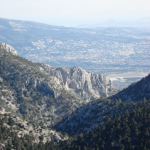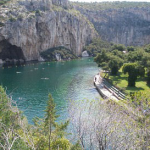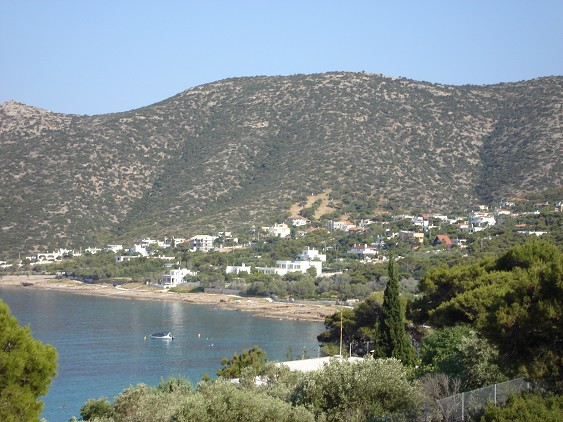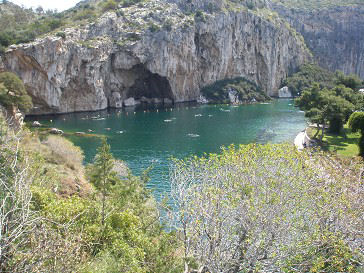
It is certain that the ancient Athenians did not select the location of their city at random. Although the heart of Athens is its center, its real strength is located twenty-five minutes out, from Syntagma Square in the center heading in every direction.
 If you take the new tram, you can visit suburbs and the lovely beaches of Athens to the south, at the Vouliagmeni lake with its cafes and restaurants well situated for a great view.
If you take the new tram, you can visit suburbs and the lovely beaches of Athens to the south, at the Vouliagmeni lake with its cafes and restaurants well situated for a great view.

Continuing north from there, you can visit the National Forest at Parnitha, a green oasis 1,500 meters high, perfect for an escape into nature. Located, only 20 minutes away from Athens.
Furthermore, in a north-easterly direction, there is Mount Penteli, named in antiquity for its cave with stalactites; the name is also given to its marble (Pentelic marble), which was used to build, among other things, the Parthenon. You can cross Attica quickly on the Attiki Odos (new national road), or by means of local roads, to reach the beaches at Loutsa, Nea Makri, and Porto Rafti.

In the opposite direction on the same highway, heading toward Corinth, you can visit the beaches of Porto Germenos, Loutraki, and Psatha.
The wider region of Attica offers many hidden treasures to the visitor, lesser-known but still very interesting images and contrasts. If you have an adventurous spirit you can enjoy the simple, daily adventures of Attica. You can’t put them in your suitcase to take home with you, but you can keep them in your mind forever as memories. Attica is perfect for visiting in day-trips out of the center of Athens.
Exploring Attica
To explore more of the region, hire a car or go bus and discover for yourselves variety of beautiful villages. Visit Messoghia its countryside is typical of the region, with its rolling hills and small villages, where you can always find a taverna and enjoy a good meal, and sample the local wine. Also worth visiting are Paenia and Lavrion once famous for its silver mines.
Piraeus
The main port and the third largest city in Greece , and is one of the largest in the Mediterranean . Piraeus lies 10km to the south of Athens.The city has always been important to Greece since classical times, as a strategic base. About 450 BC a defence wall was built which stretched from Piraeus to Athens remains of these walls can be still seen today. Other ruins from the past can also be found in the city. As well as being one of the busiest ports, Piraeus is also the centre of industry in Greece , with metal working factories, warehousing and shipping companies. The city is well planned, with wide tree lined avenues and small charming parks. The shops in Piraeus offer a wide range of goods, enough to please the most ardent of shoppers. After shopping you can relax at one of the many open air cafes. Travellers to the Greek islands are well catered for, though during the high season it can seem to be a bit chaotic. If travelling by boat to the islands, make sure you have plenty of time to find the correct ferry.
In and around Piraeus
The Archaeological Museum of Piraeus houses some artefacts discovered from the ancient theatres of Zea and Munichia. Pride of place in the museum is the bronze statues of Apollo, Athena and Artemis discovered in 1958.
The Maritime Museum contains objects and models of ships, and other exhibits relating to the nations maritime history.
The Veakeio Theatre situated on the Kastello hill, here performances take place during the summer months.
The Daphni Monastery 11km from the city along the Athens – Corinth road. This beautiful Byzantine Monastery built in the 11th century, is adorned with some of the finest mosaic art from the Byzantine era. The annual Athens Wine Festival is held nearby at the tourist pavilion.
Oropos
The sanctuary lies peacefully on the left bank of the river Cheimarros; it is dedicated to Amphiaraos a hero whom according to legend had the power of healing. He was rescued by Zeus from a battle were he was injured, it is said that the ground swallowed him when he was out driving his chariot, then miraculously reappearing through the sacred springs at this site. The sanctuary became popular, with people coming from all over Greece to take the healing waters. The ruins on the site include marble thrones that were used by the priests, during the sacrificial ceremonies, on the right bank there is a water clock dating from the 4 th century.
Mararatonas
It was here after the Battle of Marathon in 490BC when the Greeks were victorious over the Persians. The news of the victory was taken back to Athens 41km away, by a soldier running in full body armour, after giving the news he dropped dead of exhaustion. It is from this feat that the modern marathon arose.
Sounio
At the most southern tip of the mainland is Sounio here you will find the 5 th century Temple of Poseidon, standing on the headland facing the Aegean Sea, with its remaining 15 white columns of the original 34, it has been a landmark for mariners through the centuries. Here in the evening glorious sunsets can be enjoyed. Sadly to say the temple is has been vandalised by tourists carving the names into the stone, we can thank Lord Byron whom in 1810, scrawled his name on one of the columns and started precedence.
Porto Rafti
A small holiday resort and takes its name from the small island of the headland. On the island is a very large statue, built during the Roman period, it depicts a lady sitting. He area around Porto Rafti is rich in archaeology history, many ancient graves have been found around the town
The Beaches of Attica
Geographically, historically and according to state laws, Attica and Athens are connected with the sea. In the Attica basin, there are many beaches to which the Athenians and the tourists can retreat to, and to enjoy a swim during the summer months. The majority of these beaches are sandy, whilst some are pebbled. The waters are clean, and many areas have been awarded certification from the European Union.

The private, organized beaches are few, in relation to the free entrance public beaches, whilst the former are renowned for the services offered, and the latter, for their quaintness.
The quieter beaches are the ones most widely preferred by families and the elderly, without this of course being a common rule. The choices are numerous, and all wishes and preferences may be satisfied.
The Beaches of the Attica Coastline:
- Attica coast Vouliagmeni: It is situated approximately 15 kms from the centre of the capital. It is an attractive, organized beach, offering a restaurant, bar, cafés and sport facilities. Furthermore, it is also accessible to persons with mobility disabilities. One can reach it via bus lines 114, 116, 340, E22.
- Vouliagmeni Lake: The Lake at Vouliagmeni is an excellent alternative choice for a summer swim. It is 12 kms away from the center, and it encompasses a very appealing setting.

The water is usually warm. It is equipped with umbrellas and sun chairs. It also provides a café as well as a hydrotherapy unit. The bus lines servicing this area nos. 114, 116, Γ1, E22.

- Agia Marina Beach [Porto Rafti]: Located at Porto Rafti, 30 kms from Athens. One can take the bus KTEL, from Areos Park [Green Park]. It is worth the journey, because it is a particularly picturesque sandy beach. It is not an organized beach, but in the vicinity, there are restaurants and taverns.
- Agios Kosmas Beach: It is a very well known sandy beach, which is located quite near to the center. It is an organized beach with umbrellas, sun chairs and offering many other services. It is accessible to its visitors via the tram.
- Agios Nikolaos Artemidos Beach: Located in the area of Loutsa, approximately 32 kms from the centre, is the beautiful beach of Agios Nikolaos. It is not a fully organized beach, but there are bars, and its visitors can rent surfboards. The beach is accessible via private car.
- Agion Apostolon Beach [Oropos]: Situated at Oropos. It is an organized, pebbled beach, with clean waters. Accessible via the Ktel Bus line.
- Alimos Beach: It comprises of the nearest beach [8 kms] from the centre of the capital. It is located along the coastal road, and it is organized. The sun chairs are free during weekdays, whilst during the weekends, a charge of 7 euro applies. Due to its close proximity, it generally attracts many crowds. Easily accessible via the tram.
- Anavyssos Beach: The beach at Anavyssos, in front of the Eden hotel, is fully organized, and offers many services.
 |
|
There is a children’s playground, an entertainment area, beach volleyball and French ball courts, and changing rooms. It is also considered a paradise for the surfers. It is located 47 kms from Athens, and can be reached via private car or with the Ktel bus line.
Astir Palace Beach Vouliagmeni: It is one of the finest and also most loved beaches of Attica. It has been awarded the blue flag by the European Union. Located at 20 kms from Athens, it is an organized beach, offering water sports such as water-ski, jet-ski, sailing and windsurfing. It also provides a newsagency and first aid station. It is considered to be one of the most expensive beaches. The bus lines which service the area include nos. 114, 116, 340 and E22.
Asteria Beach, Glyfada: Located in the vicinity of Glyfada, 20 kms south approximately from Athens, and very near the centre of Glyfada, is this sandy beach. It is an organized and very popular beach. It provides a sea park, volleyball and football courts, and water volleyball. Parking is free. You may visit it via the bus lines E22, 114, 116, 147, E1, E2, A1, and A2.

Mavro Lithari, just off Glyfada - Avlaki Beach [Porto Rafti]: Located in the area of Porto Rafti, approximately 30 kms from Athens. It is an organized beach with umbrellas and sun chairs.

It offers a basketball court and a bar. In the area there are restaurants, taverns and fast food outlets. One may visit using the Ktel bus line, which commences from Areos Park.
- Varkiza Beach: In the area of Varkiza, 25 kms south from Athens approximately, is this organized sandy beach situated. The European Union has awarded it with the blue flag award, a certification of the cleanliness of the sea. Its visitors can play mini football, and the children can enjoy the children’s play area. There are also bars, a restaurant, as well as a first aid centre and a lifeguard unit. One may visit it via bus lines 115, 116, 125, 340, 171
- Erotospilia beach [Porto Rafti]: Located in the area of Porto Rafti, approximately 30 kms from Athens, it is a small sandy bay, with rocky outcrops and caves. Although it is not an organized beach, there is however a snack bar. It attracts the most people on weekends. One can visit it via the ktel bus line.
- Zoumberi beach [Nea Makri]: Located in Nea Makri, it is approximately 35 kms away from Athens. The beach is very popular- there is a football and beach volley court, as well as waters sport facilities, such as scuba diving. For dining, there are some fish taverns nearby. The area is accessible via the ktel bus routes.
- Kakia Thalassa Beach [Keratea]: This is an organized beach with sun chairs, umbrellas, changing rooms and showers. It provides a restaurant, and in close proximity there are also taverns. One may visit via the Ktel bus line.
- Kalamos Beach: This is a relatively quiet beach, which does not gather many crowds. The sea is clean, and the beach, sandy. There is free access to the beach, and numerous restaurants and taverns for dining in the area may be found. One may reach it via the ktel or via private car.
- Kokkino Limananki Beach [Rafina]: This beach is one of the most well known beaches in the area of Rafina. Although it is not an organized beach, it attracts many. It is located 2, 5 hours from the centre by private car. One may reach it via the ktel, from the metro station, Ethnikis Aminas.
- Lagonissi Beach: It is located approximately 35 kms from the centre and it has been given the blue flag award by the European Union. The public beach of Lagonissi is part of the Grand resort Lagonissi Hotel. The beach is organized and sandy. The services provided are many, and for this reason, it is a very expensive beach to visit. There is also accessibility for persons with mobility disabilities. Although there is a parking fee, it is preferable for one to visit by private car. Bus routes are operated by Ktel.
- Legrenon Beach: Located near Sounion, and approximately 60 kms from the centre of the city, this is a very popular beach during the summer months. It is a sandy beach, although not organized. Nearby, there are some taverns. The area is serviced by ktel bus lines.
- Marikes Beach [Rafina]: This is a sandy beach within the vicinity of Rafina, located 32 kms from the centre of the city. There are very few facilities. There is a bar and a volleyball court. The area is serviced by ktel, from the metro station, Ethnikis Aminas.
- Mati beach [Nea Makri]: This is one of the most popular beaches in Nea Makri. It is a sandy beach, with free access. The only public transport available is via the ktel.
- Nea Palatia Beach [Oropos]: Located at Oropo, this is an organized pebbled, and not sandy beach. One may visit using the ktel.
- Nea Makri Beach: This is an organized beach with umbrellas, sun chairs, showers, and swimming platforms. Bus timetables are operated by ktel, commencing from Areos Park.
- Sesi Beach [Marathona]: A non-organized sandy beach in Marathona, which attracts the crowds on the weekends. If you don’t have the use of a private car, the bus routes of Ktel service the area.
- Psatha Beach: Thus is a beach in the vicinity before Porto Germenos. It is 2 kms in length, and is located 66 kms from Athens. It is not an organized beach, and it is accessible via ktel.
 Beach of Psatha
Beach of Psatha
Beach of Psatha - Voulas Beach A’ & B’: Located at approximately 17 kms from the centre of Athens, these are considered the most popular due to their proximity and beauty. They offer long stretches of sandy beach and are organized with facilities. Amongst the services offered, these include water sports. There are bars, restaurants, changing rooms, beach volley and football courts and water slides. In particular, beach A’ has been awarded the blue flag by the European Union. The following bus lines service the area: A1, E1, E1Θ Ε2Θ, 114, 115, 116, 138,149,162,163.
- Beaches in Kavouri: At Kavouri, approximately 10 kms from the centre, there are picturesque sandy gulfs ideal for swimming. These beaches offer free access, and gather many crowds. There are also many cafés, refreshment stalls, and snack restaurants situated within the area. The area is serviced by bus lines E1Θ, Ε2Θ, 114, 115, 116, 138, 149 and 340.
- Beaches at Porto Germeno: Porto Germeno is located 60 minutes away from Athens. There are long stretches of sandy and pebbled, clean beaches. Despite its distance, the beaches attract many crowds. There are also water sport facilities available. For dining, visitors may seek out the neighboring fish taverns. The area is facilitated with the ktel bus routes, although it is preferable for one to travel by private car.
- Shinia – Karavi Beaches [Marathona]: In the area of Marathona, one may find the beaches of Shinia and Karavi. These are one of the most preferred beach destinations in Attica. They are located approximately 43 kms north of Athens, and they are organized with umbrellas, sun chairs, bars, restaurants and other services. It is recommended for water sports. Football and volleyball courts are also available, and on certain days, bungee jumping is possible. Timetables in the area are operated by ktel.
Tips / General Information:
- If you have your own private means of transport, then it is preferable to choose a more distant beach location.
- If you wish to enjoy your swim at a quiet beach, then do not favor those beaches in close proximity to Athens.
- Greeks do no visit the beaches early in the morning. Peak hours are at noon and after. If you want to avoid the crowds, venture out to the beach early on in the morning.
- Choose weekdays for your outings. The majority of people visit the beaches during the weekends.
- Wherever you choose to visit, calculate the traveling time required, the time of departure, and the traffic on the roads.
- At the organized beaches, charges for the services offered are considerable. Entrance fees range from 4-10 euro. Umbrella rental is approximately 5 euro, and 4 euro per sun chair. Parking fees may also apply.
- In close proximity to many free access public beaches, you will find snack bars and canteens.
- The canteens and refreshment stalls at organized beaches, and not only, have very often more expensive rates for their products. A bottle of water, for example, may sell for up to 2 euro. The same applies also for a coffee [3-4 euro], sandwiches [2.5 -3 euro] and for ice-cream.
- Bus and tram timetables are relatively frequent, now in summer. The ktel timetables are not as regular. Before you start out, be informed of the timetables for the routes required [ www.ktelattikis.gr , www.oasa.gr , www.tramsa.gr , www.ametro.gr ] The price for public transports costs one euro, while a ktel bus ticket varies according to the area.
Museums of Athens
Athens is home to an astonishing variety of museums, representing Greek and international cultural accomplishment from prehistoric art to modern cartoons, from archaeology to modern technology, from stamps to shells.
This wide variety reflects the importance the Athenians place on the sharing of cultural material – Athens is likewise a center of performance, sport, and literature. The Athenians’ pride in their city’s past and present is evident in such projects as the exhibition space in the new stations of the Attic Metro (especially at Syntagma Sq., Panepistimio, and Evaggelismos stations), and in the various visible archaeological excavations around the city. Making up the balance are a large number of private art and jewelry galleries.
Visiting the museums is easy – many of them are located in the pedestrian center between Syntagma, Monastiraki/Plaka, and the Acropolis. Those that are located away from the center are mostly accessible by the Attic Metro. Any stay in Athens of as little as a day is bound to include visits to some of this city’s world-famous museums. Art lovers, history buffs, and culture vultures should take the time to seek out some of the smaller, but still excellent, museums and exhibition spaces dotting the city. A selection of the some of the most important museums as well as some little-known gems follows.
Unless otherwise signed, photography is permitted inside museums as long as the flash feature is turned off. To use a tripod, a flash, or a video-camera, you must apply for a permit. Greek law prohibits the photography of people standing in front of or beside exhibited pieces. This law is strictly enforced.
- National Archaeological Museum
- Epigraphical Museum
- National Historical Museum
- Acropolis Museum
- Kanellopoulos Museum
- Museum of Traditional Musical Instruments
- Museum of Greek Folk Art
- Agora Museum
- Museum of the Kerameikos
- Benaki Museum
- Goulandris Museum of Cycladic and Ancient Greek Art
- Byzantine and Christian Museum of Athens
- National Gallery and Alexandros Soutzos Museum
- Other Notable Museums of Athens
Transportation
The quickest means of transportation in Athens (aside of course from walking, which is best for the center of the city) is the Metro (lines 2 and 3) which also covers transportation from and to the Athens International Airport. It runs daily from 5:30am until 12:30am.
For information, including schedules and fares: http://www.ametro.gr Customer Service: 801-801-8011
The older line of the same system, known as the Electric Railway, or Line 1, runs from Kifisia to Peiraias with many transfer points to the two lines of the Metro. It runs daily from 5:30am until 12:30am.
For information, including schedules and fares: http://www.isap.gr Telephone: +30 210-324-8311 until 5:00pm
The most heavily used transportation system is the Bus and Trolley system.
For information: http://www.oasa.gr Telephones: 210.8836076, 210.8836080, 210.8839414, 210.8839416, 210.8200999.
Don’t forget to check the bus itineraries from and to the Airport.
The most recent addition to Athens’ transportation has been the tram, which connects the central region of the city to Palaio Faliro through Nea Smyrni, and at Palaio Faliro forks along the coastal road in one direction toward Alimo, Elliniko (the old airport), and Glyfada, and in the other direction toward Faliriko Delta and Neo Faliro, terminating at the Peace and Friendship Stadium.

For information: http://www.tramsa.gr Telephone: 210.9978000
Another method of transportation is by taxi; they have the lowest fares in all of Europe. Athens and Attica taxis have a characteristic yellow color and are equipped with meters, which display the charge; the driver is required to use the meter.
From 5:00am until midnight, the driver charges regular fare; between midnight and 5:00am, he doubles the fare.
The Suburban Railway (Proastiakos) covers the route from Athens to the International Airport (with seven station stops in between) as well as other routes, including Athens to Corinth, or the entire way from Corinth to the airport.

For information, visit: http://www.proastiakos.gr
To visit other cities and towns in Greece from Athens, the best way to travel is by long-distance bus, known as KTEL.
For information and itineraries, visit: http://www.ktel.org
Alternatively, you can make many trips on the train system. You can get to the Athens train station from the metro by getting off at the Stathmos Larisis stop, which is on the Red Line.
For more information, visit: http://www.ose.gr Customer Service: 1110


 |
|



 Beach of Psatha
Beach of Psatha



















